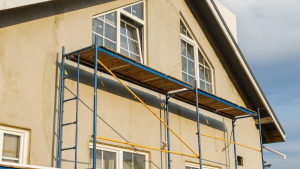Stucco is a durable, low-maintenance material that can enhance the aesthetic, curb appeal, and value of your property. However, a number of climatic factors and issues with the craftsmanship of your stucco could lead it to decay. Now let’s quickly go over them.
Most frequent reasons for stucco failure
Stucco is a durable, low-maintenance material that can enhance the aesthetic, curb appeal, and value of your property. However, a number of environmental and workmanship-related problems could result in the breakdown of your stucco.
Improper door or window sill installation
If a door or window is installed incorrectly or poorly, water may not be able to effectively drain off the building, which could cause problems. When it comes to windows, water may be trapped if a stucco installer didn’t properly place water-resistant paper behind the glass, which could result in mold growth and structural damage.
If there isn’t a solid barrier keeping moisture out, your stucco work will crack and eventually deteriorate.
Incorrect installation of the flasher
If your kick-out flashing diverters—one-piece molded plastic or metal elements intended to properly guide water flow—are missing or improperly installed, you could expect to see cracking and deterioration in your stone and stucco work.
Improperly sealed vents, electrical outlets, and other moisture entrance points
To prevent moisture intrusion, which can cause stucco failure and other structural problems, dryer vents, light fixtures, pipelines, and electrical outlets should also be constructed similarly to how window frames should be. These holes should be totally watertight in addition to having appropriate water management systems around them.
An improperly installed deck
A knowledgeable deck builder should use water management strategies including barrier membranes, rain screens, and ledger board drip can flashing to protect the rim joist and anything below it (even stucco). This is crucial when dealing with larger decks. A knowledgeable stucco inspector can identify any potential problems or provide advice on how to protect your stucco if you plan to add a deck.
Transitional issues with the materials
Transitions between stucco and other building materials, such as stone, concrete, siding, and brick, can be problematic if all connections between these dissimilar materials have not been correctly sealed for expansion and contraction, which can lead to and worsen both cracking and water penetration. Flashing can assist prevent substantial damage to stucco, just as it is essential to ensure that water drains effectively around windows, doors, and chimneys.
Call our stucco experts if you live close to Wayne for inspections, construction, or repairs.


